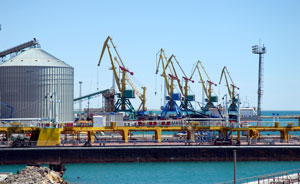 AKTAU – This city is known as Kazakhstan’s primary sea access point on the Caspian Sea and the hub of the Mangystau region. And now this major strategic transport area has become part of multi-modal hub that includes the large Dostyk and Khorgos railway stations, on the other side of the country, on its border with China.
AKTAU – This city is known as Kazakhstan’s primary sea access point on the Caspian Sea and the hub of the Mangystau region. And now this major strategic transport area has become part of multi-modal hub that includes the large Dostyk and Khorgos railway stations, on the other side of the country, on its border with China.
In the next few years, the volume of cargo passing through the area is expected to increase significantly because all of the transportation companies using the area will be organized into a single logistics chain.
The effort to create the multi-modal hub was approved by the head of state. The organisation of the multi-transportation companies into a single logistics chain will increase the flexibility of all links in the transport chain in order to integrate the port into the global transportation network.
“Our country as a major player is interested in becoming a world trade logistics hub. Every year about 16 million tons of cargo pass through Kazakhstan,” Berik Uandykov, director of the State Enterprise Aktau International Sea Commercial Port, said.
In the next seven years, transit freight traffic is expected to increase 10 fold to 170 million tons and revenues to the state budget are set to grow accordingly.
“Being in a favourable geographical position, we must fully realise the existing potential. With this aim, we commissioned two major railway sections: Zhetygen-Korgas and the Uzen-border with Turkmenistan with further access to the Persian Gulf. In addition, we have begun construction of a new railway line, Beineu-Zhezkazgan. Thereby, Kazakhstan today, investing in the construction of transport nodes, reduces routes by hundreds of kilometres and creates favourable conditions for the transportation of export-import and transit cargoes. In addition, these projects will help in promoting our products to world markets,” Uandykov said.
The transfer of the Aktau port to the management of the national railways company KTZ (Kazakhstan Temir Zholy), which will become in the future a multimodal transport and logistics operator, is expected to help attract funds for further development of the port.
Crude oil now accounts for three quarters of cargo shipment through the port, but these volumes will significantly reduce after the expansion of the Tengiz-Novorossiisk CPC pipeline. Nevertheless, in the long term, cargo handling in the port will be 20 million tons.
In recent years, the average annual increase in the shipments through the Aktau seaport have increased more than three fold .
“Now the port of Aktau is actively implementing measures aimed at increasing the capacity of the ferry terminal. In 2001, the design production capacities were around one million tons per year. At present, this value has been exceeded by 2.5 times. In addition, over the past three years we have seen a nine-fold increase in ferry transportation, Uandykov added.
Full implementation of a large-scale project towards the north from its current position will also allow the port of Aktau to handle more than 5 million tons of dry cargo per year, which in turn will give a new impetus to the port’s dynamic and effective development.


